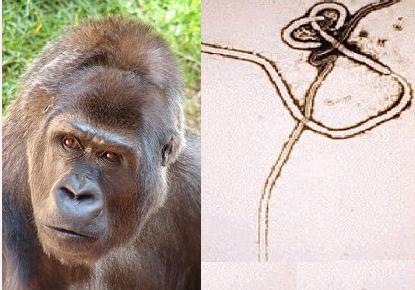Researchers estimate that in the last 12 years, Ebola has caused the death of 5,000 gorillas

Researchers estimate that in the last 12 years, Ebola has caused the death of 5,000 gorillas. When you add to this amazing number the fact that in the animal areas of the gorillas the killing continues by a hunter, a hunter whose aim is to satisfy the growing demand for meat from the forest, you get a grim picture, according to the primatologist Dr. Magdalena Bermaggio from the University of Barcelona, the combination of the hunter and the attack by Ebola will lead to the extinction of the gorillas (the report is presented in the scientific monthly Science. ).
According to the researcher: Ebola spreads faster among gorillas than among people, since according to the World Health Organization, in a period in which 5,000 gorillas died, 1,200 people died, a figure that seems surprising, and it is also unclear how the virus passes between gorillas.
Researchers estimate that it is possible that the gorillas catch the virus from other animals (bats?) or pass it between them. how ? Unknown . In July, a study was published that shows that the virus passes between members of the group, the new study showed that there is a transition between the groups, that is, the spread is not limited to geographical living areas, since different groups share overlapping living areas and thus different groups eat fruits from the same trees and leave their excrement in the same places.
Gorillas (like chimpanzees) touch, smell and mess with the corpses of gorillas or other monkeys, and this is how the virus passes and infects different populations and groups. The Ebola that was discovered in 1976 is a viral injury that causes internal bleeding and in 70% of cases death, the virus is transmitted by direct contact (blood in blood or body fluids). Researchers estimate that the virus "jumped" to humans from primates, when hunting, slaughtering and eating.
When the virus attacks, there is no reliable treatment, but there is a vaccine to prevent infection. The team of researchers led by Dr. Bermaggio surveyed groups of gorillas in the Lusai reserve in the south-west of Congo, until 2002 10 groups were identified with 143 individuals. In 2001-2002 there was an outbreak that affected people on the Gabon-Congo border, in October 2002 32 dead gorillas were identified, of which 9 individuals were tested and the identification was positive (Ebola). Most of the details were known (personally) to the researchers. At the end of the survey period (2005) 221 gorillas were counted who died of Ebola. The researchers estimated that this number constitutes about a quarter of the gorilla population in their area of work, estimating the population of gorillas in Africa at 20,000 individuals. By Emdan, who relied on the knowledge of the population in the various regions, the researchers arrived at the astonishing number of 5,000.
That means again in the last 12 years a quarter of the gorilla population died from Ebola. When you add to this the reduction of living areas and the wild hunter, you get a sad picture! Dr. Peter Walsh, an ecologist from the Max Planck Institute for Evolutionary Anthropology who accompanied the research, claims that it is possible to try and prevent the extinction by adapting the existing vaccine and distributing it in the gorilla populations, this at the price of several million dollars. Now looking for donors.
